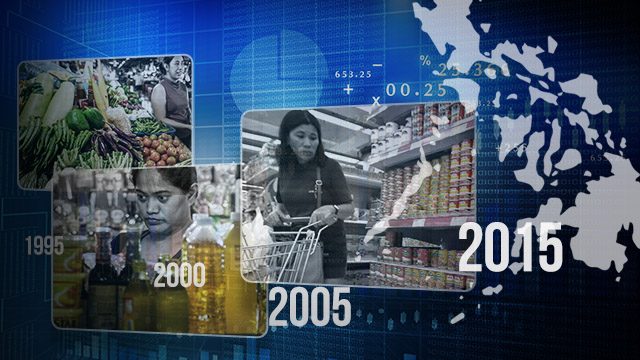SUMMARY
This is AI generated summarization, which may have errors. For context, always refer to the full article.

MANILA, Philippines – The country’s inflation rate rose from 6.4% in August to 6.7% in September 2018, according to the Philippine Statistics Authority (PSA).
September’s inflation rate is the highest in over 9 years. It was also the 9th consecutive monthly inflation rate increase, which started in January 2018. (EXPLAINER: How inflation affects you)
The government’s economic managers and some businessmen have said the recent inflation levels are “mere hiccups” and are “manageable.”
Some have even attempted to compare the inflation rates against past administrations, to justify the current levels. (READ: [ANALYSIS] Viral misconceptions about inflation, how to debunk them)
Inflation under past presidents
In using historical inflation data, the base year of the data should be taken into account.
The base year serves as the reference or benchmark “to which a continuous series of index numbers can be related,” and at which “the [CPI] is taken as equal to 100,” explained the PSA.
Data with the same base year are comparable to each other.
“The CPI is used because it is meaningless to assign a peso value to the basket of goods and services,” said economist JC Punongbayan. He added that the base year changes from time to time because the components of the basket of goods change over time as well.
To illustrate the effect of base years on the data, here is a graph showing the inflation rates from January 1986 to September 2018 under different base years:
As of this posting, current PSA data on inflation are computed using base year 2012. Inflation data for this base year was from 2013 onwards. Until June 2018, the PSA also used base year 2006.
To make inflation data comparable across all years, the PSA has “backcasted” or recomputed inflation data using base year 2012.
Here is a graph of the annual inflation rate since 1958.
Notice the high inflation rates recorded in the 1970s and 1980s, during the time of then-president Ferdinand Marcos. The earlier ones were fueled by various factors like the devaluation of the peso, massive government spending, skyrocketing world oil prices, and a series of typhoons.
The peak annual inflation rate of 49.8% in 1984 (50.3% using base year 2006) was due to “Marcos’ pernicious policy of debt-driven growth and crony capitalism,” said Punongbayan. (READ: [ANALYSIS] Golden age? Inflation reached 50% during the Marcos regime)
There was also high inflation during the latter end of the Cory Aquino administration, when monthly inflation rates soared above 20% in 1991. That year’s annual inflation rate stood at 19.4%.
“Remember that the Philippines was coming from a time of economic crisis back in the mid-1980s,” explained Punongbayan. He added that Cory Aquino’s administration was rocked by a power crisis, multiple coup attempts, and a series of natural disasters.
In the years that followed, Punongbayan said the government implemented better economic management, aided by reforms in the Bangko Sentral ng Pilipinas (BSP), the country’s central bank.
Section 3 of Republic Act 7653 or the New Central Bank Act, signed in 1993, stated that the BSP’s primary objective is “to maintain price stability conducive to a balanced and sustainable growth of the economy. It shall also promote and maintain monetary stability and the convertibility of the peso.”
Punongbayan also pointed out that in 2002, the BSP formally adopted “inflation targeting” or the announcement of an inflation target, with the promise “to achieve it over a given time period.”
“Under inflation targeting, the central bank compares actual headline inflation against inflation forecasts. The central bank uses various monetary policy instruments at its disposal to achieve the inflation target,” explained the BSP.
Meanwhile, the last double-digit monthly inflation rate recorded was in September 2008, when it hit 10.1% (using base year 2012) under the Arroyo administration. Before that, it was 10.2% in July and 10.5% in August also in 2008.
(But using base year 2000, it was higher at 12.3% in July, 12.4% in August, and 11.8% in September.)
Punongbayan said this coincided with the global rice crisis. In the few months after that, inflation rates went down because of an influx of rice imports and the global financial crisis, which slowed down overall economic growth. The annual inflation was eventually recorded at 8.2% in 2008.
Under the Duterte administration, Punongbayan said in an opinion piece that the country’s high inflation rates are caused not just by rising world oil prices.
Other factors also contribute to it, such as the effect of the tax reform law on the price of petroleum products, the weakening peso, and people’s expectations of inflation. – Rappler.com
Read other Rappler reports and analysis on inflation:
- IN CHARTS: Carinderia, sari-sari store owners feel pinch of inflation
- More Filipinos unhappy with Duterte gov’t handling of inflation – poll
- Duterte may issue EO to address inflation
- Rappler Talk: Economist Emmanuel de Dios on soaring inflation under Duterte
- LOOK: Cooking pinakbet under sizzling inflation
- [ANALYSIS] Mere hiccups? Let’s be more honest about the economy
- IN CHARTS: What your P100 can buy under runaway inflation
- Government should worry about sky-high inflation – economists
Add a comment
How does this make you feel?
There are no comments yet. Add your comment to start the conversation.